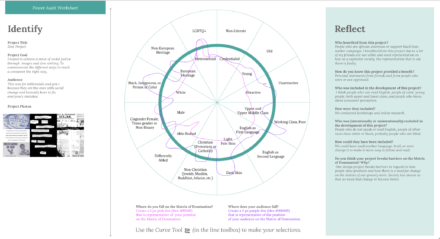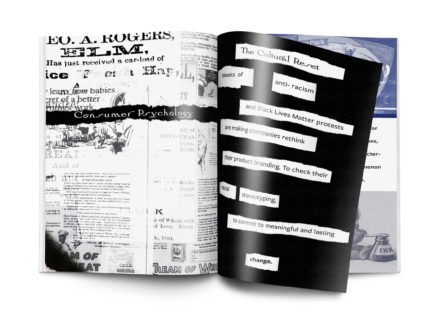The Link Between Imagery and Social Justice
Design Process and Testing
Working with a team to discover new ways to inform and incite change through the common use of a zine required a lot of testing and research. First we were handed with the controversial brand “Cream of Wheat”. With this, we had to look at other resources that either had the same social issues or commerce issues. We had to find the purpose, the rationale, the evidence, the takeaway and finally a theme to which we could inscribe into our own piece. This was a way to check secondary sources for reliability and credibility so that our project was not made of of opinions, but credible information.
We tested our themes that we came up with when we were done with researched and matched them to the research we have done for the Cream of Wheat brand. These themes were somewhat of a struggle to minimize the quantity of topics to discuss. We also needed to figure out a classic, yet modern design for our zine that matched with our topic of social injustice as well as consumer prejudices.
Design Solution
We finally came to our themes which were Perception, Rebranding, and Systematic Racism. Our design was split into these three groups with subtext. We split the project of 16 pages and everyone had around 3 pages to do. My design solution was to make it as realistic as possible through the uses of collage and duotone imagery. This is to keep with the style of the zine. The black and white colors represent the severity of the topic while the blue tie in the brands colors to American Capitalism.
Project Description
The project was for students to discover the history of a certain brand and better understand their role in consumer society. The challenge was to discover what the brand Cream of Wheat was and how it is perceived throughout history and how we can make a change with what goods on our shelves. A zine best accomplishes the goal of wide spread audience as well as highlighting the importance of consumer psychology. Our approach was to brainstorm themes based off of our research and try to come up with the best reasons of why we are creating the zine.
Outcomes of our brainstorming and workshops resulted in a ripped paper design with black and white as the main colors. One important insight that I found interesting was how each step in the process was crucial to fully understanding the project challenge . This project helped with limiting the mistake of exclusivity.
Who Was Included
My collaboration with my teammates included Katie Becker, Rachel Anthony, Erin Lorigan, and Alex Faiello helped create the social criticism on the brand through designing a zine. The external collaborators were our professor Zack Tucker who critiqued our work to establish a more cohesive zine. Everyone equally participated , but to be more specific, my role in the group was to give ideas, questions, and feedback , do research, and make three pages of the final zine. The audience of the project was people who could read and understand English, and for people who are or need to be educated in consumer psychology when it comes to social and racial awareness.
Research
The forms of research that took place for this specific project was reading about the issues of racism and how that affects the way we view certain products at our local grocery store. Reading articles from the Times and even more scholarly work from Forbes and other magazines who have a significant influence on society. I even went further to research the statement from Cream of Wheat themselves about the racial issue that has been highly talked about in this modern era. One article described consumer perception to imagery on packages and how that implicit bias creates a domino effect into a real life scenario. The fact that the brand themselves acknowledged the not so tasteful imagery of their famous black chef into situations that are racially discriminatory , it shows that if they can change, so can society, even if it is one box at a time. Statistics on how many racial imagery or history is rooted into companies products is weighed heavily in the United States and actions are starting to arise as time goes on. Change will happen, hopefully for the better.
Design Approach
At first we knew that research needed to be done to understand more on the topic which we created through an extensive chart. https://docs.google.com/document/d/1qvFBkWX-Bkm6W7GBfFV3hJP387GLvE69G6XsoDkF0qY/edit?usp=sharing
Once we knew more about the themes of our brand we went ahead and brainstormed about what we found interesting, our initial insights, and how we could implement them into our final design. https://jamboard.google.com/d/1j5gVXRQpV8EINDpHaSNPuqbsq4W9r10J-5Qke2AJUm0/edit?usp=sharing
After we brainstormed and came up with our themes , it was time to play around with the layout of our zine. There was a varying difference concerning the layout, however we did come to a decision that we all agreed upon. The feedback from our color choices to the ripped paper was taken well with our critique . The feedback from my group was to narrow down my images and pick out which ones would be the most effective. So, I chose images that could correlate with social injustice and consumer psychology since that was to be my theme to hit on in the zine.
Final Deliverable
Reflections
This project was very important in how everyone can learn to design for inclusitivioty. With the Black Lives Matter Movement , historical brands such as Cream of Wheat took a reflection into how they impact the consumer in a small or big way. The framework into created a zine, formally for a wide spread audience, is to research and get to know who your audience is. Brainstorming with post cards and a group is beneficial into discovering new and unique ideas on how to push a specific message across. Anyone can get involved in making a zine and all they need to do is research, find out exactly what they want to say and who will read them. However, also keep in mind the inclusitivioty of your design methods. For instance, is one’s audience English speaking? Age group? Race? ect. Going through my power audit, there is always things I can improve on such as illiterate people, different religions from mine, and age. I believe I have successfully reached literate, people of color, and class.


